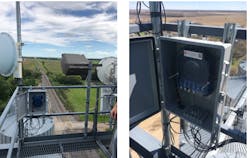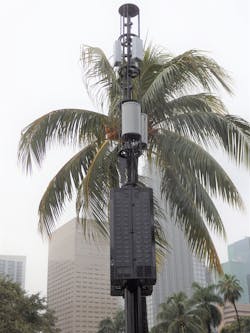Starting in 1995, work began within industry standards organizations to define a new technology called passive optical networks (PONs) for fiber to the home (FTTH) deployment. The first large-scale PON deployment in the United States came a few years later as Verizon began fiber-based PON deployments in 2004.
Today, the industry is finding new ways to use PON beyond FTTH. What began a quarter-century ago is now the preferred fiber technology deployed throughout the network to over 26.5 million homes in the United States.1 Central to PON are the use of splitters, fiber management, fiber delivery, and fiber protection. Many people think of PON only from the perspective of the active equipment--optical network terminals (ONTs) and optical line terminal (OLTs). However, the physical fiber technology used to connect these PONs is finding use beyond traditional FTTH.
Rural
Many rural-based service providers deliver voice, data, cable TV, home security, advertising services, and more. So today’s rural networks handle vast amounts of traffic of many types. And in today’s world of COVID-19, getting reliable broadband connections out to rural communities is critical for survival. Beyond the connections, the way people use this technology to support telehealth, smart farming, and distance learning are the new normal along with COVID-19 lockdowns. The ability to re-use fiber technology for multiple applications is key. For example, we are seeing fiber connectivity that was initially designed for PON now being used in wireless backhaul for rural carriers.
As wireless and faster connections become a greater necessity, rural service providers increasingly need to find ways to create point-to-point wireless backhaul connections in their network. The sparsely populated topography in rural areas presents unique challenges for these carriers. Feeding wireless backhaul sites requires tall structures, but traditional fiber-fed towers are not available.
Working within the service provider’s requirements, the fiber management system included a specially mounted outdoor-rated wall box equipped with a fiber cassette, the fiber drops, and fiber jumpers. This company got creative in solving their unique wireless backhaul challenge.
At the top of the structure, the wall box was equipped with a 24-fiber LC/APC cassette terminated with the 300-foot flat drop fiber going to the splice point on the ground. The pigtail end was installed first in a 2-inch conduit that ran from the top of the tall structure down to where the outside plant (OSP) cable terminated. Splicing to the pigtail was done on the ground in an equipment cabinet with a splice tray. The radio side of the assembly has a protective sleeve and a collar to ensure network integrity.
This wireless backhaul approach differed from a traditional application because it needed to work with radio components not specifically designed for fiber and required custom pieces such as protective sleeves. Yet the service provider got 24 fibers to the top of the grain elevator with one cable and the entire fiber install took less than two hours.
Municipalities
Municipalities face unique challenges when determining the right broadband technology – one that benefits their citizens the most but requires the least amount of disruption. We see that the demand for bandwidth is directly correlated to population density. The more people within a community, the more likely you are to see construction projects for new fiber network builds.
And that includes builds to enable 5G wireless technology, which is expected to need hundreds of thousands of points-of-presence (small cell sites), each connected by fiber, to become ubiquitous. The U.S. government drafted rules through the FCC removing barriers to 5G technology. They set up a streamlining process to decrease the cost of building out the small cells by almost a third. That’s good for consumers, who will likely have multiple providers operating in their area. But that also means each wireless carrier (spectrum owner) will have 5G enabled radio equipment and antennas to mount within the municipality. This fact puts the municipality under pressure to deal with additional 5G permit applications along with necessary inspection costs – as well as a fiber management problem, as we’ll see.
Fiber-optic technology is often overlooked when talking wireless, but the fiber is essential. The whole goal of a wireless network is to move from an over-the-air interface to a fiber-optic broadband connection as quickly as possible. This transition to fiber in the wireless network has progressively moved closer and closer to the end-user device. 2G/3G had fiber to the macro cell tower. 4G saw fiber pushed out to the small cell. 5G is expected to push fiber even further down to each point-of-presence (antennas) within the serving area. And fiber is needed because of its intrinsic physical characteristics—fast as the speed of light, low-latency, secure, reliable, and easy to deploy.
The PON wave of fiber deployment for FTTH over the last decade has spawned innovations like the fiber cassette. These cassettes are now finding their way into 5G small cell deployments. The need to access multiple fibers, maintain bend radius, protect the fibers, and scale to any size deployment go hand in hand with these 5G buildouts.
Summary
Due to the increasing demands of mobile streaming, wireless carriers are looking for creative solutions to improve and reinforce their mobile network capacity. However, transitional cell-site deployment scenarios and network architectures pose challenges for network infrastructure providers to standardize on a single solution. They need a scalable, single product architecture enabled by a modular product platform for flexible, cost-effective, and rapid fiber deployment. Standardization of passive fiber equipment using a variety of equipment housings across multiple wireless carriers improves efficiency and service turn-up time as learning curves are reduced.
As you can see, the multiple uses of fiber-optic PON technology have spawned even more applications that are being deployed just in time to meet high demand. Our industry is poised for continuous innovation as we look to the future.
References
1. “Fiber Broadband Association Research Shows Record Fiber Broadband Growth in North America,” Fiber Broadband Association, December 17, 2019.
Kevin Morgan leads the marketing efforts for Clearfield as chief marketing officer. He joined the company in 2016. He also currently serves as an officer of the Fiber Broadband Association’s Board and is a two-time elected Board Chair (2015 and 2019) after first joining the Board in 2010.
About the Author
Kevin Morgan
Chief Marketing Officer
Kevin Morgan leads the marketing efforts for Clearfield as chief marketing officer. He joined the company in 2016. He also currently serves as an officer of the Fiber Broadband Association’s Board and is a two-time elected Board Chair (2015 and 2019) after first joining the Board in 2010.



